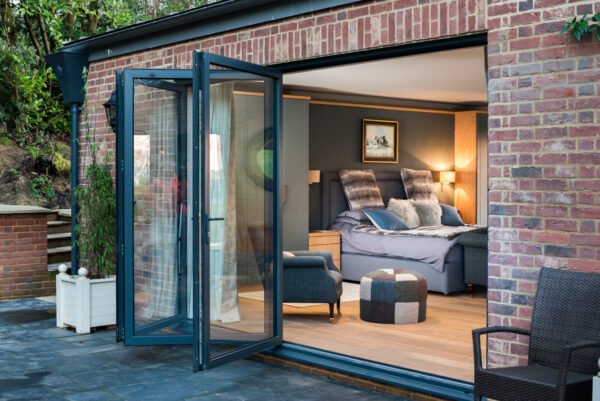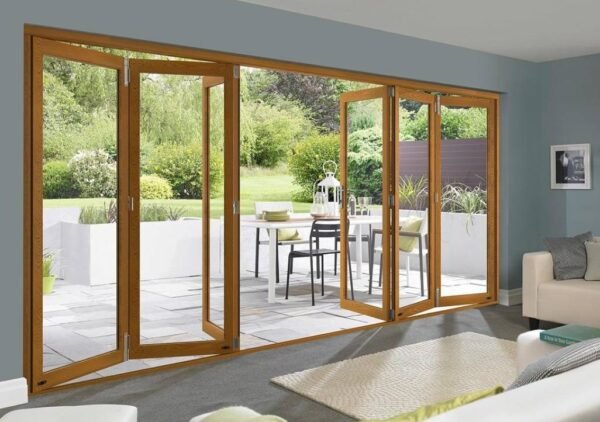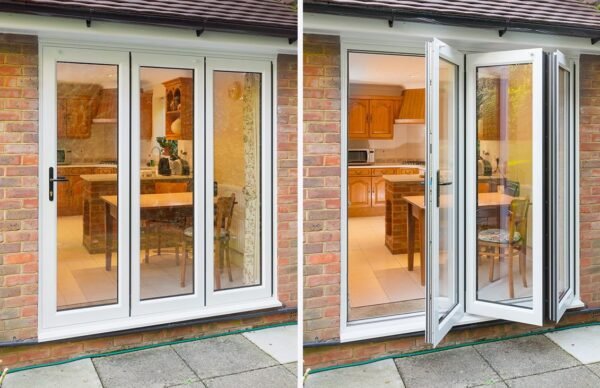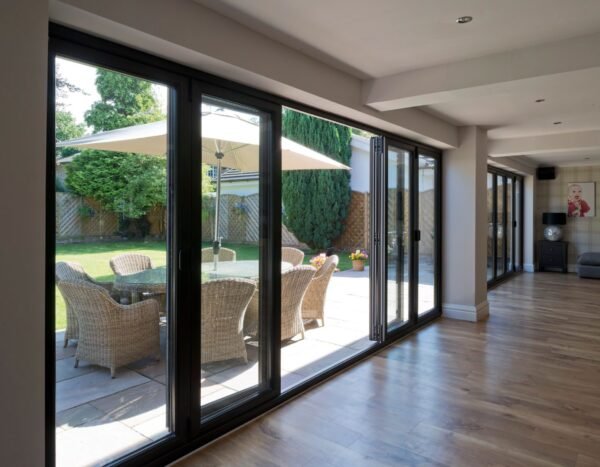
The choice of doors is crucial in modern architecture and interior design. Among the various types available, aluminium and uPVC bifold doors are popular options. Both materials offer distinct advantages, making the decision-making process challenging for homeowners or architects.
With this expert guide, we delve into the characteristics, benefits, and drawbacks of aluminium and uPVC bifold doors, assisting you in making an informed choice for your space.
Understanding Aluminium Bifold Doors

Aluminium bifold doors have gained widespread recognition for their sleek appearance and durability. Crafted from robust aluminium frames, these doors offer exceptional strength and stability, ensuring longevity and minimal maintenance requirements.
The inherent strength of aluminium allows for slim profiles, maximising natural light ingress and providing unobstructed views of the surroundings.
One of the primary advantages of aluminium bifold doors lies in their resistance to corrosion, making them ideal for various climatic conditions.
Compared to other materials, aluminium bifold doors are much more resistant to weather conditions and are less likely to warp and swell. Aluminium doors retain their aesthetic appeal without succumbing to environmental factors.
Additionally, aluminium’s malleability allows for intricate designs and customisation options, catering to diverse architectural preferences.
Exploring uPVC Bifold Doors

On the other hand, uPVC bifold doors offer a compelling alternative, particularly in terms of affordability and energy efficiency. Crafted from unplasticised polyvinyl chloride (uPVC), these doors boast excellent thermal insulation properties, contributing to reduced energy consumption and lower utility bills.
The insulating capabilities of uPVC help maintain comfortable indoor temperatures year-round, enhancing overall energy efficiency within the premises.
Furthermore, uPVC bifold doors are renowned for their low maintenance requirements and resistance to rot, rust, and fading.
Unlike traditional timber doors, which may require periodic painting or sealing, uPVC doors retain their colour and finish over time, retaining their aesthetic appeal with minimal upkeep.
This aspect makes uPVC bifold doors an attractive option for homeowners seeking hassle-free solutions without compromising on quality or style.
Compared to aluminium bifold doors and other door materials, uPVC is usually among the cheapest for initial cost, although some long-term issues could actually mean you pay more over time.
Comparing Durability and Longevity
When considering durability and longevity, both aluminium and uPVC bifold doors offer commendable performance, albeit with slight variations. Aluminium doors excel in terms of strength and resistance to external elements, making them suitable for high-traffic areas or locations prone to harsh weather conditions.
The robust nature of aluminium ensures long-term reliability, providing peace of mind to homeowners seeking a lasting investment.
Conversely, uPVC doors exhibit impressive durability coupled with low maintenance requirements, making them an appealing choice for budget-conscious individuals or those prioritising energy efficiency.
Although uPVC is the cheaper option of the two, they are more prone to damage or warping than aluminium is, which means you may have to repair or replace them more often. This could make the long term costs of uPVC bifold doors actually higher than when compared to aluminium.
Aesthetic Appeal and Customisation

In terms of aesthetic appeal and customisation options, both aluminium and uPVC bifold doors present numerous possibilities to suit various architectural styles and design preferences. Aluminium doors offer sleek, contemporary profiles with clean lines, making them ideal for modern residences or commercial spaces seeking a minimalist aesthetic.
The versatility of aluminium allows for a wide range of finishes, including powder coating, anodising, or wood grain effects, enabling seamless integration with existing decor schemes.
Similarly, uPVC doors come in an array of colours and finishes, catering to diverse tastes and design requirements. Whether opting for a traditional look with wood-effect uPVC or a bold statement with vibrant hues, homeowners have ample choices to personalise their space according to their vision.
Choosing the Ideal Bifold Doors
Ultimately, the choice between aluminium and uPVC bifold doors boils down to individual preferences, budget constraints, and specific project requirements. While aluminium doors offer unparalleled strength, durability, and contemporary aesthetics, uPVC doors excel in terms of affordability and energy efficiency.
By weighing the advantages and drawbacks of each material against your priorities, you can make an informed decision that enhances the functionality and aesthetics of your living or working space. Using traffic doors will improve the overall architectural appeal of the building.
When it comes to selecting bifold doors, it’s essential to consider factors such as climate, architectural style, maintenance needs, and budgetary considerations.
Whether opting for the robustness of aluminium or the cost-effectiveness of uPVC, both materials offer viable solutions for creating seamless transitions between indoor and outdoor spaces while adding value to your property.
